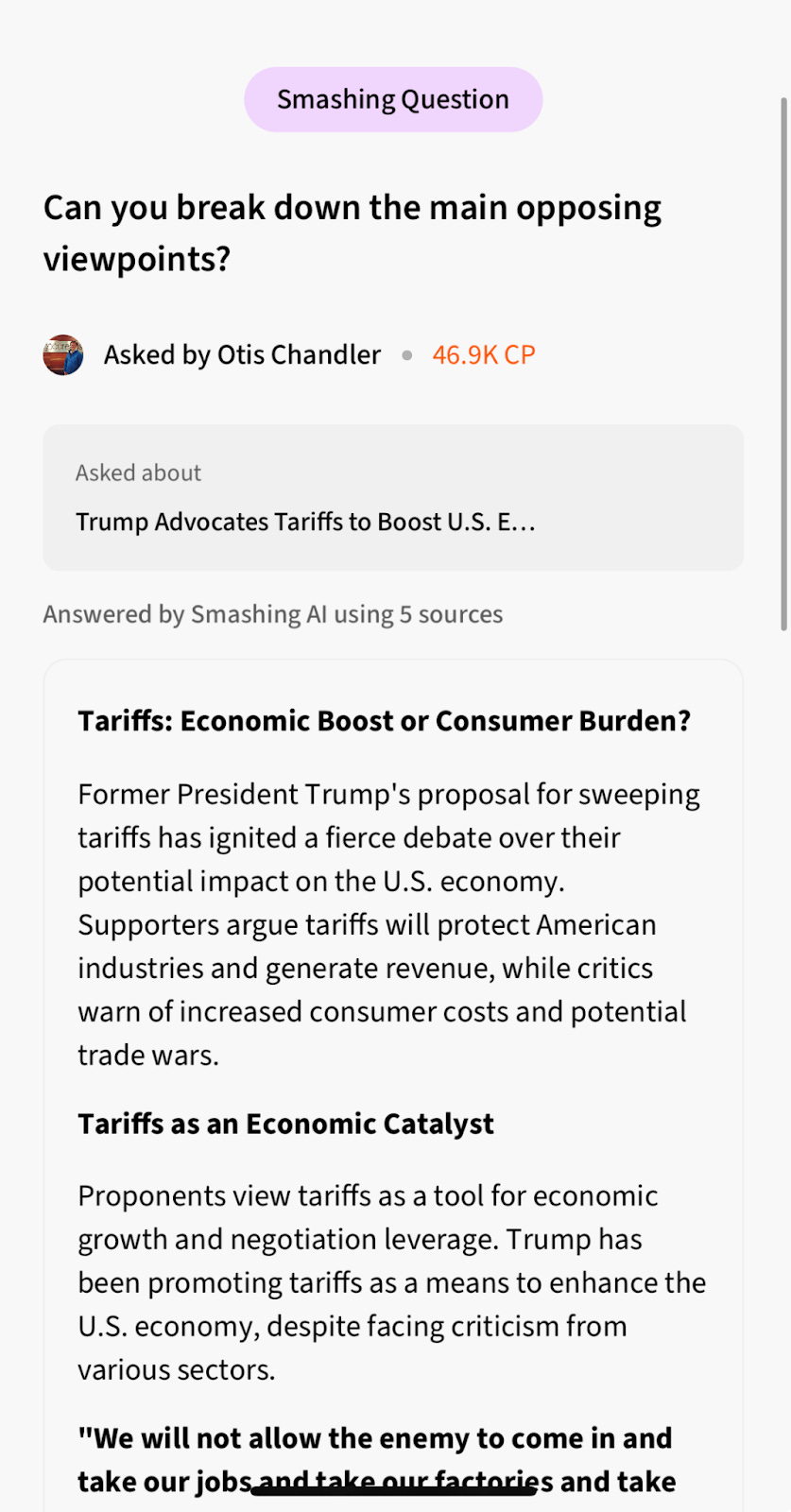Smashing Spotlight: The Power of Reading Both Sides
An opinion piece from Smashing CEO Otis Y. Chandler, plus the week’s most upvoted articles.
This week, Smashing CEO Otis Y. Chandler shares his thoughts on why reading across competing perspectives is essential for understanding complex issues. With the U.S. presidential election in just three days and 81% of voters naming the economy as their top concern, how can readers avoid being limited by polarized viewpoints and see the full picture? Otis argues that engaging with multiple perspectives isn’t just valuable—it’s essential for deeper understanding.
But first, here are some of the most upvoted articles on Smashing this week:
“Google Preps AI That Takes Over Computers” | The Information
“The Hard Truth: Americans Don’t Trust the News Media” | The Washington Post
“A TikTok Alternative Called Loops is Coming for the Fediverse” | The Verge
“The Billionaires Hedge their Bets” | Platformer
“More Than a Quarter of New Code at Google is Generated by AI” | The Verge
The Surprising Power of Reading Both Sides
By Otis Y. Chandler
With the presidential election in just a few days, 81% of voters say the economy is their top concern. Yet when asked about solutions, they diverge sharply along party lines. How can so many agree on the problem yet envision entirely different paths forward? And how can we, as readers, better navigate this complexity?
To truly understand an issue, it stands to reason, you must understand all its substantive perspectives. But most of us aren’t in the habit of seeking other viewpoints—it's extra work, and frankly, on issues that have become more philosophical than data-driven, we often don't want to hear the other side. Why spend our limited time on opinions we don't agree with?
Here’s my take: Engaging with differing perspectives isn’t just valuable—it’s the best way to learn. Only by doing so can we fully grasp the issues and better understand what’s happening in our country.
Historically, media policies like the Fairness Doctrine (1949-87) promoted balanced reporting, building public trust. Today’s media, however, is fragmented into a landscape of partisan news outlets and opinion-driven commentary. This splintering often leaves readers with only one emphatically expressed side of an issue, making it each individual reader’s responsibility to seek a more balanced view.
Add to this the fact that Americans' trust in the media has fallen sharply. For the third consecutive year, trust remains at an all-time low, with 36% expressing no trust at all (Gallup). Recently, Jeff Bezos, owner of The Washington Post, highlighted this crisis of confidence in an op-ed, warning that when society loses faith in media, it risks losing agency and perspective within democracy. Again, from Gallup’s most recent polling: “The news media is the least trusted group among 10 U.S. civic and political institutions involved in the democratic process.” Put simply, the unofficial fourth branch of government—the press—now ranks as less trustworthy than politicians.
Bezos’s op-ed further stresses that, as trust dwindles, people increasingly turn to unverified sources like podcasts, social media, and blogs, risking greater misinformation. The Washington Post and The New York Times still win awards for journalism, but more and more, they speak primarily to elites rather than to all Americans. I respect Bezos, having worked for him for six years, and I’m glad he’s working toward restoring trust in the media.
The Los Angeles Times also opted not to endorse a candidate this year—a stance my grandfather, a former LA Times publisher, also took decades ago, choosing impartiality after a controversial endorsement of Nixon and helping elevate the LA Times to likely one of its finest eras in journalism.
But the modern media landscape now includes not just mainstream outlets, but also blogs, substacks, podcasts, and social media—where, let’s face it, many Americans get their information today. Some of this content is richly informative; other parts, lacking research or verification, risk spreading bias or misinformation.
At Smashing, we’ve been grappling with this issue. Let’s look at the economy and tariffs as an example. Trump’s proposed tariffs could significantly impact the U.S. economy. However, people have vastly different views on this topic.
How can readers get a comprehensive view of this policy’s implications? At Smashing, we curated a story on this topic with 19 relevant pieces. By clicking “Show both sides” in the Smashing app, you get an AI summary of each side, with sources highlighted.
For instance, I was surprised to learn that John Paulson suggested the tariffs would target specific industries, or that the Biden/Harris administration recently enacted a 100% tariff on Chinese EVs. I also clicked on our “poke holes” prompt and liked some of the theories it mentioned.
Source: Smashing AI Answer
This curated story reflects my own and a few others’ attempt to present differing and, at times, opposing perspectives, and it’s obviously not exhaustive. We’ve designed Smashing such that if other curators add in worthwhile pieces, the answers that Smashing AI gives will incorporate them. How that works is a complicated balance between various data signals and we are still working on turning it given that Smashing just launched. But the factors we look at are: the worthwhile votes the articles in the story grouping receive, the publisher reputations, the reputation (Curator Points) of the people who did the curating, and the number of articles saying the same things.
After spending a great deal of time in the past month tapping “Show me both sides” on all political or investing or bilateral articles I read, I’ve been surprised how often it helps me better understand the issue. So much so that I now firmly believe that a tenet of Smashing is helping people read more diversely. I want to help build a world where people approach issues with greater empathy for all relevant perspectives.
I invite you to try it for yourself and share your thoughts with my cofounders and me on how Smashing can help readers better navigate today’s increasingly complex issues.




